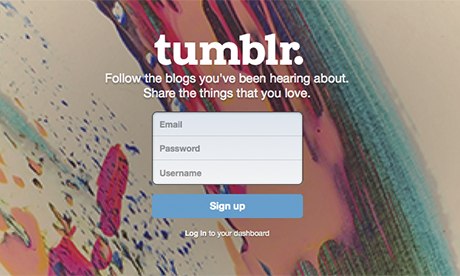
Although only a year younger than the ubiquitous Twitter, blogging platform Tumblr is less well-known - unless you're a teenager. Its highly-visual format and the ease with which it allows users to share content have seen it attract a rapidly growing user base, particularly among a younger audience, and it is now starting to make an impact in the arts.
There are over 140 million Tumblr sites, with more than 103 million posts every day. Tumblr users are characterised by their dedication to the site, with visit times typically longer than those to both Twitter and Facebook. To give you an idea of how importantly Tumblr is viewed, web giant Yahoo shelled out $1.1bn earlier this year to acquire the platform, promising shocked users that it wouldn't change how the site operated.
For the uninitiated, Tumblr is a cross between a blog and a social network. You choose other Tumblr blogs to follow, and content from those blogs appears in a stream, in a very similar way to social networks like Facebook or Instagram. Users post photos, videos and text updates to their Tumblrs, and other users can like, comment on or 'reblog' the content - the latter being similar to a retweet on Twitter, and a fundamental feature of Tumblr. As with Twitter, hashtags are used extensively to tag content.
Its popularity with a younger audience comes down to the highly visual nature of most Tumblr content - particularly photos and animated GIFs - together with its simple functionality and the speed at which material can be posted and (crucially) shared. It has also invested heavily in creating dedicated mobile apps to make it easy to post from anywhere.
While Tumblr, in terms of users, is still relatively small when compared to platforms like Facebook and Twitter, some sectors have seen its fast adoption. The arts and culture sector is one such area. Some topics, which have reached a critical mass of blogs, are now featured by Tumblr in its Spotlight section - including museums.
But why would you decide to set up a Tumblr blog for your organisation? It could be because you're trying to reach a younger demographic, have highly visual content to share, or simply because it is so easy to maintain - easier, some would argue, than a full-blown blog.
The Horniman Museums and Gardens in London decided to set up a Tumblr blog - In the Horniman - to showcase artefacts from its collection that, due to reasons of space, were not on display.
Adrian Murphy, the museum's digital media manager, explained why they fixed on Tumblr for the project. 'Tumblr seemed like the right platform for unique, interesting mainly photographic content,' he says. 'On a practical level, Tumblr is very easy to update, since it can be done on the phone via the mobile app. This means that it was relatively straightforward for the team to take a photo, add a description and upload it without too much additional work. Using a shared login also means that multiple people can feed into the same Tumblr blog.'
The museum has seen high engagement on the blog and although it is early days, Adrian says they are pleased with the reaction to it.
When the education outreach team at the Museum of Modern Art (MoMA) in New York noticed that the age demographic of their Facebook page was getting older, they set up MoMA Teens - a vibrant, attention-grabbing Tumblr that aims to introduce more teens to their organisation, and to the world of art.
To ensure the content posted to Tumblr engages the target audience, two teenagers with a deep understanding of MoMA's ethos run it. One, 19-year-old Alya Albert, describes what she sees as the reason why Tumblr works in the arts and culture sector: 'Tumblr is instant visual stimulation, and I think that's why it brings art and teens into a happy union.'
Like any blog or social network account, it's important that your organisation has a clear strategy for how and why you want to use Tumblr, as well as the resource and commitment to keep it updated. Like any social network, it takes time to get Tumblr right. But, with the right thought behind it, and investment of time, it may well prove to be the right platform for you.
Case studies on the above and more are available for free download on This content is brought to you by Guardian Professional. To get more articles like this direct to your inbox, sign up free to become a member of the Culture Professionals Network. CultureHive. Katie Moffat is a freelance digital and social media strategist at Prandsocial - follow her on Twitter @katiemoffat
Tidak ada komentar :
Posting Komentar